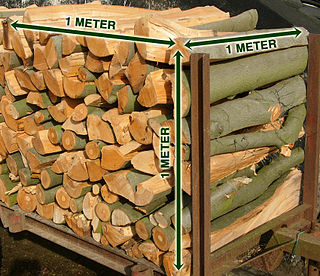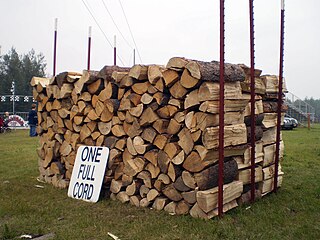Related Research Articles
The British thermal unit is a measure of heat, which is a form of energy. It was originally defined as the amount of heat required to raise the temperature of one pound of water by one degree Fahrenheit. It is also part of the United States customary units. The SI unit for energy is the joule (J); one BTU equals about 1,055 J.

The litre or liter is a metric unit of volume. It is equal to 1 cubic decimetre (dm3), 1000 cubic centimetres (cm3) or 0.001 cubic metre (m3). A cubic decimetre occupies a volume of 10 cm × 10 cm × 10 cm and is thus equal to one-thousandth of a cubic metre.

Ton is any of several units of measure of mass, volume or force. It has a long history and has acquired several meanings and uses.

United States customary units form a system of measurement units commonly used in the United States and most U.S. territories, since being standardized and adopted in 1832. The United States customary system developed from English units that were in use in the British Empire before the U.S. became an independent country. The United Kingdom's system of measures was overhauled in 1824 to create the imperial system, which was officially adopted in 1826, changing the definitions of some of its units. Consequently, while many U.S. units are essentially similar to their imperial counterparts, there are significant differences between the systems.

A grain is a unit of measurement of mass, and in the troy weight, avoirdupois, and apothecaries' systems, equal to exactly 64.79891 milligrams. It is nominally based upon the mass of a single ideal seed of a cereal. From the Bronze Age into the Renaissance, the average masses of wheat and barley grains were part of the legal definitions of units of mass. Expressions such as "thirty-two grains of wheat, taken from the middle of the ear" appear to have been ritualistic formulas. Another source states that it was defined such that 252.458 units would balance 1 cubic inch (16 cm3) of distilled water at an ambient air-water pressure and temperature of 30 inches of mercury (100 kPa) and 62 °F (17 °C) respectively. Another book states that Captain Henry Kater, of the British Standards Commission, arrived at this value experimentally.
The foot (pl. feet), standard symbol: ft, is a unit of length in the British imperial and United States customary systems of measurement. The prime symbol, ′, is commonly used to represent the foot. In both customary and imperial units, one foot comprises 12 inches, and one yard comprises three feet. Since an international agreement in 1959, the foot is defined as equal to exactly 0.3048 meters.

The cubic inch is a unit of volume in the Imperial units and United States customary units systems. It is the volume of a cube with each of its three dimensions being one inch long which is equivalent to 1/231 of a US gallon.
The cubic foot is an imperial and US customary (non-metric) unit of volume, used in the United States and the United Kingdom. It is defined as the volume of a cube with sides of one foot in length. Its volume is 28.3168 L.
The board foot or board-foot is a unit of measurement for the volume of lumber in the United States and Canada. It equals the volume of a one-foot (305 mm) length of a board, one foot wide and one inch (25.4 mm) thick.

The stere or stère (st) is a unit of volume in the original metric system equal to one cubic metre. The stere is typically used for measuring large quantities of firewood or other cut wood, while the cubic meter is used for uncut wood. The name was coined from the Greek στερεός stereós, "solid", in 1795 in France as a metric analogue to the cord. The unit was introduced to remove regional disparities of this former unit, for which the length could vary greatly from 6 to 13.5 m. It is not part of the modern metric system (SI) and is no longer a legal unit in France, but remains used in the commerce of firewood.
The long ton, also known as the imperial ton or displacement ton, is a measurement unit equal to 2,240 pounds (1,016.047 kg). It is the name for the unit called the "ton" in the avoirdupois system of weights or Imperial system of measurements. It was standardised in the 13th century. It is used in the United Kingdom and several other Commonwealth of Nations countries alongside the mass-based tonne defined in 1799, as well as in the United States for bulk commodities.

A barrel is one of several units of volume applied in various contexts; there are dry barrels, fluid barrels, oil barrels, and so forth. For historical reasons the volumes of some barrel units are roughly double the volumes of others; volumes in common use range approximately from 100 to 200 litres. In many connections the term drum is used almost interchangeably with barrel.

The acre-foot is a non-SI unit of volume equal to about 1,233 m3 commonly used in the United States in reference to large-scale water resources, such as reservoirs, aqueducts, canals, sewer flow capacity, irrigation water, and river flows.
English units were the units of measurement used in England up to 1826, which evolved as a combination of the Anglo-Saxon and Roman systems of units. Various standards have applied to English units at different times, in different places, and for different applications.

The cord is a unit of measure of dry volume used to measure firewood and pulpwood in the United States and Canada.
The cubic ton is a measure of volume. It is considered obsolete in the United Kingdom and is now used primarily in the United States.
The hoppus cubic foot was the standard volume measurement used for timber in the British Empire and countries in the British sphere of influence before the introduction of metric units. It is still used in the hardwood trade in some countries. This volume measurement was developed to estimate what volume of a round log would be usable timber after processing, in effect attempting to ‘square’ the log and allow for waste. The hoppus ton (HT) was also a traditionally used unit of volume in British forestry. One hoppus ton is equal to 50 hoppus feet or 1.8027 cubic meters. Some shipments of tropical hardwoods, especially shipments of teak from Myanmar (Burma), are still stated in hoppus tons.

A unit of volume is a unit of measurement for measuring volume or capacity, the extent of an object or space in three dimensions. Units of capacity may be used to specify the volume of fluids or bulk goods, for example water, rice, sugar, grain or flour.
References
- 1 2 3 4 5 Cardarelli, F. (2003). Encyclopaedia of Scientific Units, Weights and Measures. Their SI Equivalences and Origins . London: Springer. pp. 52. ISBN 978-1-4471-1122-1.
- ↑ Charles Pope (1819). "CCXLIII". Practical abridgement of the laws of customs and excise (5th ed.).
- ↑ John Ramsey McCulloch (1840). "Docks on the Thames (London)". A Dictionary Practical, Theoretical and Historical of Commerce and Commercial Navigation. Vol. 1. Thomas Wardle. p. 590.